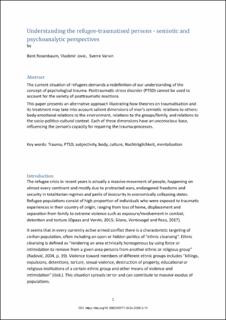| dc.contributor.author | Rosenbaum, Bent | |
| dc.contributor.author | Jovic, Vladimir | |
| dc.contributor.author | Varvin, Sverre | |
| dc.date.accessioned | 2021-01-30T16:51:06Z | |
| dc.date.accessioned | 2021-03-08T15:03:03Z | |
| dc.date.available | 2021-01-30T16:51:06Z | |
| dc.date.available | 2021-03-08T15:03:03Z | |
| dc.date.issued | 2020 | |
| dc.identifier.citation | Rosenbaum B, Jovic V, Varvin S. Understanding the refugee-traumatised person. Semiotic and psychoanalytic perspectives. psychosozial. 2020(43) | en |
| dc.identifier.issn | 0171-3434 | |
| dc.identifier.uri | https://hdl.handle.net/10642/9925 | |
| dc.description.abstract | The current situation of refugees demands a redefinition of our understanding of the concept of psychological trauma. Posttraumatic stress disorder (PTSD) cannot be used to ac‐ count for the variety of posttraumatic reactions. This paper presents an alternative approach illustrating how theories on traumatisation and its treatment may take into account salient di‐ mensions of man’s semiotic relations to others: body-emotional relations to the environment, relations to the groups/family, and relations to the socio-politico-cultural context. Each of these dimensions have an unconscious base, influencing the person’s capacity for repairing the trau‐ ma-processes. | en |
| dc.language.iso | en | en |
| dc.publisher | Nomos Publishing | en |
| dc.relation.ispartofseries | Psychosozial;43. Jg., Nr. 161, Heft III | |
| dc.subject | Trauma | en |
| dc.subject | Posttraumatic stress disorders | en |
| dc.subject | Subjectivity | en |
| dc.subject | Bodies | en |
| dc.subject | Cultures | en |
| dc.subject | Nachträglichkeit | en |
| dc.subject | Mentalisation | en |
| dc.title | Understanding the refugee-traumatised person. Semiotic and psychoanalytic perspectives | en |
| dc.type | Journal article | en |
| dc.type | Peer reviewed | en |
| dc.date.updated | 2021-01-30T16:51:06Z | |
| dc.description.version | acceptedVersion | en |
| dc.identifier.doi | https://doi.org/10.30820/0171-3434-2020-3-11 | |
| dc.identifier.cristin | 1883376 | |
| dc.source.journal | psychosozial | |
| dc.source.volume | 43 | |
| dc.source.issue | 161 | |
